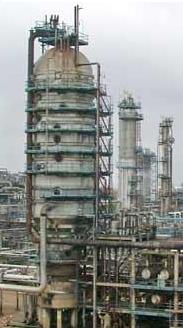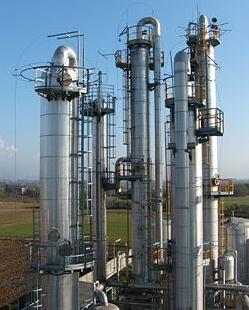User:Milton Beychok/Sandbox: Difference between revisions
imported>Milton Beychok |
imported>Milton Beychok |
||
| Line 47: | Line 47: | ||
The design of a distillation column depends upon the composition and the thermal condition of the feed as well as the composition of the desired products. The [[McCabe-Thiele]] method and the [[Fenske equation]] maybe used to design simple binary distillation columns. | The design of a distillation column depends upon the composition and the thermal condition of the feed as well as the composition of the desired products. The [[McCabe-Thiele]] method and the [[Fenske equation]] maybe used to design simple binary distillation columns. | ||
For a multi-component feed, computerized ''simulation models'' are used for the design as well as the subsequent operation | For a multi-component feed, computerized ''simulation models'' are used for the design as well as the subsequent operation of the column. Simulation models are also used to adjust the operation of existing columns for the distillation of feed compositions that are somewhat different than the feed composition for which the column was originally designed. | ||
Many industrial uses of continuous distillation operate 24 hours per day for 2-5 years between routine, scheduled shutdowns. The operational control of a distillation column may be performed by advanced computer control systems but highly experienced workers are still required to oversee the online, real time operations and to provide routine maintenance as needed. | Many industrial uses of continuous distillation operate 24 hours per day for 2-5 years between routine, scheduled shutdowns. The operational control of a distillation column may be performed by advanced computer control systems but highly experienced workers are still required to oversee the online, real time operations and to provide routine maintenance as needed. | ||
=== Column feed === | === Column feed === | ||
Revision as of 22:30, 19 July 2008

A vacuum distillation column in a petroleum refinery.
Continuous distillation is an ongoing separation process in which a liquid mixture of two or more miscible components is continuously fed into the process and physically separated into two or more products by preferentially boiling the more volatile (i.e., lower boiling point) components out of the mixture.[1][2][3][4]
Large-scale, continuous distillation is very commonly used in the chemical process industries where large quantities of liquids have to be distilled, as in petroleum refining, natural gas processing, petrochemical production, hydrocarbon solvents production, coal tar processing, the liquefaction of gases such as hydrogen, oxygen, nitrogen, and helium), and other low-temperature processing.
Industrial distillation is typically performed in large, vertical cylindrical columns (see the adjacent photographs) commonly referred to as distillation columns, distillation towers or fractionators with diameters ranging from about 65 centimetres to 11 metres and heights ranging from about 6 metres to 60 metres or more.
To provide for the intimate mixing of the upward flowing vapor and downward flowing liquid in distillation columns, they usually contain a series of horizontal distillation trays or plates (see Figure 3). The distillation trays or plates are typically separated by about 45 to 75 centimetres of vertical distance. However, some columns are designed to use beds of packing media rather than trays or plates.
Distillation is one of the fundamental unit operations of chemical engineering. If the feed contains more than two components, it is commonly referred to as multi-component distillation and, if it contains only two components, it is referred to as binary distillation.
If the distillation column feed contains a very great number of components (such as is the case in distilling petroleum crude oil), separation into pure components is impractical and such columns are therefore designed to yield fractions which are groups of components within a desired range of boiling points. Those fractions are probably the origin of the terms fractional distillation and fractionation.
There are a number of other forms of distillation such as vacuum distillation, batch distillation, steam distillation, extractive distillation and azeotropic distillation which are not included in this article.
The process
When a liquid mixture is heated so that it boils, the evolved vapor will have a higher concentration of the more volatile (i.e., lower boiling point) components than the liquid mixture from which it evolved. Conversely, when a vapor mixture is cooled, the less volatile components tend to condense in a greater proportion than the more volatile components.
Figure 1 schematically illustrates what happens in a distillation column. A liquid mixture is fed into the distillation column. On entering the column, the heated feed is partially vaporized and rises up the column. However, as it rises, it cools by contacting the descending cooler liquid and partially condenses so that, while part of vapor continues to flow upward, the condensed portion is enriched in the less volatile component(s) and flows downward. As the vapor continues to flow upward, it undergoes partial condensation a number of times and each time becomes richer in the more volatile component(s).
The part of the feed liquid that did not vaporize on entering the column, flows downward and is heated by contacting the upflowing hotter vapor until it is partially vaporized. The resulting vapor flows upward and the residual liquid is enriched in the less volatile component(s) and flows downward. As the liquid continues to flow downward, it undergoes partial vaporization a number of times and each time becomes richer in the less volatile component(s).
The distillation trays in the column are designed to facilitate the intimate contacting of upward flowing vapor with downward flowing liquid (see Figure 3).
The overhead vapor that exits the top of the column is rich in the more volatile component(s) of the column feed and the bottoms liquid which exits the bottom of the column is rich in the less volatile component(s) of the column feed.
(Note: In distillation terminology, when a liquid or vapor mixture attains a higher concentration of some component, it is referred to as being enriched, rich or richer in that component. Also, the more volatile components are called the lighter components and the less volatile components are called the heavier components.)
Heat is required to provide the multiple occurrences of partial vaporization in a distillation column. The required heat is applied to the bottom of a distillation column in a number of ways, the most common being the transfer of heat from a reboiler.
Similarly, cooling is required to provide the multiple occurrences of partial condensation that also occur in a distillation column. The required cooling is most usually provided by a condenser used to cool and condense the overhead vapor into a liquid and then returning part of the cool condensed liquid to the top of the column as reflux.
The overhead condenser may be water-cooled or air-cooled. The bottoms reboiler may be a heat exchanger heated by steam or hot oil, or it might be a fuel-fired furnace. The location of the feed entry can vary from one design to another and is selected to provide optimum results (see McCabe-Thiele method).
A continuous distillation column is kept in a steady state or approximate steady state. In the context of continuous distillation, that means that the feed rate, output product rates, reflux rate, heating and cooling rates, temperatures, pressures, and compositions at every point within the column are essentially kept constant during operation. It also means that the column is material-balanced and heat-balanced (i.e., the material inputs equal the material outputs, and the heat inputs equal the heat outputs). If a variation in conditions does occur, modern process control equipment is usually able to gradually return the system to a steady state again.
Design and operation
The design of a distillation column depends upon the composition and the thermal condition of the feed as well as the composition of the desired products. The McCabe-Thiele method and the Fenske equation maybe used to design simple binary distillation columns.
For a multi-component feed, computerized simulation models are used for the design as well as the subsequent operation of the column. Simulation models are also used to adjust the operation of existing columns for the distillation of feed compositions that are somewhat different than the feed composition for which the column was originally designed.
Many industrial uses of continuous distillation operate 24 hours per day for 2-5 years between routine, scheduled shutdowns. The operational control of a distillation column may be performed by advanced computer control systems but highly experienced workers are still required to oversee the online, real time operations and to provide routine maintenance as needed.
Column feed
- ↑ Kister, Henry Z. (1992). Distillation Design, 1st Edition. McGraw-Hill. ISBN 0-07-034909-6.
- ↑ King, C.J. (1980). Separation Processes. McGraw Hill. 0-07-034612-7.
- ↑ Perry, Robert H. and Green, Don W. (2007). Perry's Chemical Engineers' Handbook, 8th Edition. McGraw-Hill. ISBN 0-07-142294-3.
- ↑ McCabe, W., Smith, J. and Harriott, P. (2004). Unit Operations of Chemical Engineering, 7th Edition. McGraw Hill. ISBN 0-07-284823-5.

